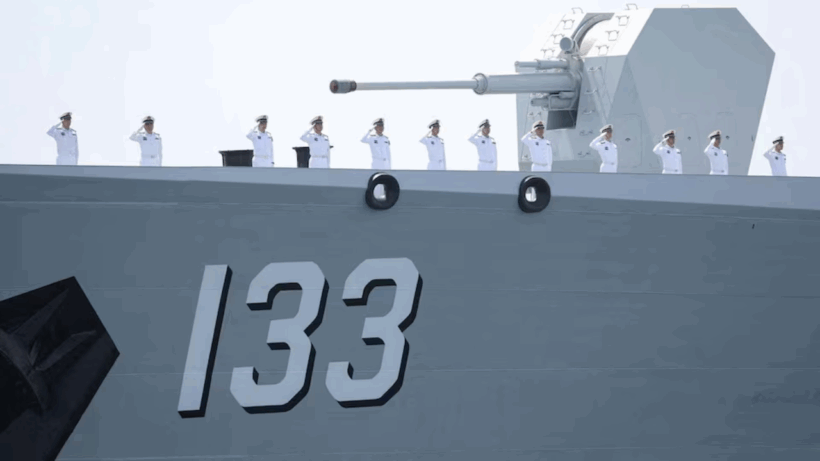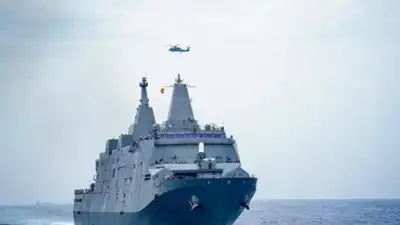⚓ China Naval Activity Surges in East Asia, Raising Regional Tensions
In a significant escalation, China has dramatically increased its naval operations throughout East Asian seas, causing growing alarm among neighboring nations.
Since early May 2025, defense officials across the region have observed an unprecedented surge of Chinese naval vessels and coast guard ships navigating key maritime corridors.
This fleet, noticeably larger than usual, has been spotted near Taiwan, the southern Japanese archipelago, and contested areas within the East and South China Seas. Classified security reports obtained by Reuters reveal a clear demonstration of China’s assertive naval ambitions.
🚢 Recent Military Drills Amplify China’s Maritime Reach
Earlier this year, on March 12, 2025, China participated in a high-profile naval exercise in the Gulf of Oman alongside Iran and Russia.
This joint drill exhibited China’s growing capacity to operate far beyond its immediate coastal waters. Now, back in East Asia, China’s naval movements have intensified significantly.
Military analysts note that China’s aircraft carrier and accompanying fleet have sailed dangerously close to Japan and Taiwan, raising alarms about potential strategic provocations.
🌏 Strategic Motives Behind the Naval Escalation
Experts believe China’s intensified naval presence is an effort to assert control over the “first island chain” — a critical maritime barrier stretching from Japan through Taiwan to the Philippines.
This region acts as a natural choke point between China and the wider Pacific Ocean. China’s increased ship activity here sends a pointed message: it intends to expand its influence and challenge existing maritime norms in these contested waters.
🚨 Unprecedented Scale of Naval Deployments
Security insiders emphasize the unusual composition of these operations. Instead of routine patrols, the current deployments mix warships, coast guard vessels, and auxiliary support ships, enabling China to display both military strength and governance over disputed territories, particularly in the South China Sea.
For Japan and Taiwan, this is perceived as a direct challenge to their sovereignty, prompting both nations to heighten military readiness and surveillance.
🔥 Regional Fallout: Heightened Alert and Defensive Measures
The surge in Chinese naval presence has serious implications. Taiwan, which China claims as its own, views the buildup as a potential prelude to conflict.
Japan has strengthened its naval defenses, especially around the southern islands that serve as strategic outposts.
The East China Sea, home to contentious territories like the Senkaku Islands, remains highly volatile. Governments across the region are reassessing defense strategies amid the growing pressure from Beijing’s naval expansion.
🚀 Symbolic Power Projection Through Aircraft Carrier Deployment
The appearance of a Chinese aircraft carrier near Taiwan and Japan marks a rare and provocative demonstration of naval power projection. Aircraft carriers are powerful symbols of national strength, and deploying one near these sensitive zones underlines China’s readiness to contest the dominance of other regional powers, including the United States.
🌐 Geopolitical Risks and the Path Ahead
China’s growing naval presence threatens to upset the fragile balance in East Asia. Neighboring countries like South Korea and the Philippines are closely watching developments.
The United States, a strategic ally in the region, may respond with increased naval operations, risking further escalation.
Although diplomatic avenues remain active, the situation is volatile, with missteps potentially leading to serious confrontations.
📚 Understanding the Maritime Dynamics
For those interested in the broader context of these tensions, institutions like the Council on Foreign Relations provide detailed analyses of regional maritime security challenges.
China’s naval moves are part of a larger strategy to assert dominance without triggering open warfare, employing coast guard ships to enforce claims while avoiding outright conflict.
⚔️ Diverse Regional Reactions and Strategic Dilemmas
Taiwan has amplified its naval patrols, while Japan advocates for greater international cooperation to safeguard freedom of navigation.
Smaller nations caught between China and the U.S. face difficult decisions: either align more closely with American interests or attempt to manage relations with China. These geopolitical choices are complex, with significant consequences for regional peace and stability.
🔍 The First Island Chain: A Critical Maritime Battleground
China’s expanding naval footprint transforms the first island chain from a simple geographic concept into a crucial theater of power struggle.
With tensions mounting, the coming months will reveal whether China’s naval surge leads to constructive dialogue or heightened conflict in this strategically vital region.
For more updates about China Naval Activity Surges in East Asia, Raising Regional Tensions, explore the Current News. Feel free to share your thoughts and comments.
If you’re passionate about building a successful blogging website, check out this helpful guide at Coding Tag – How to Start a Successful Blog. It offers practical steps and expert tips to kickstart your blogging journey!











